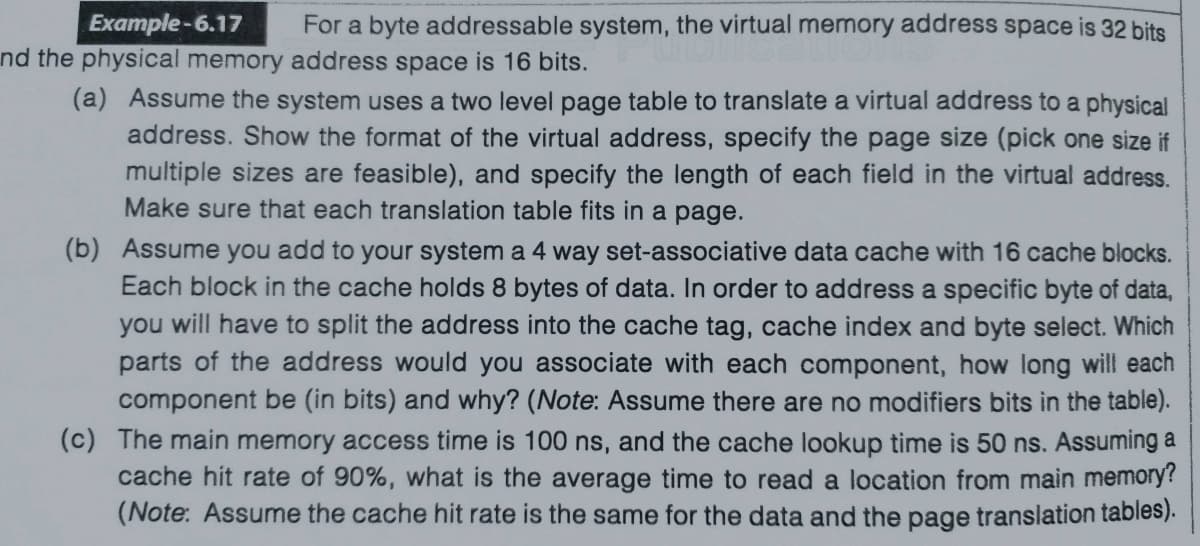Example-6.1 For a byte addressable system, the virtual memory address space is 32 bits the physical memory address space is 16 bits. (a) Assume the system uses a two level page table to translate a virtual address to a physical address. Show the format of the virtual address, specify the page size (pick one size if multiple sizes are feasible), and specify the length of each field in the virtual address. Make sure that each translation table fits in a page. (b) Assume you add to your system a 4 way set-associative data cache with 16 cache blocks. Each block in the cache holds 8 bytes of data. In order to address a specific byte of data, you will have to split the address into the cache tag, cache index and byte select. Which parts of the address would you associate with each component, how long will each component be (in bits) and why? (Note: Assume there are no modifiers bits in the table). (c) The main memory access time is 100 ns, and the cache lookup time is 50 ns. Assuming a cache hít rate of 90%, what is the average time to read a location from main memory? (Note: Assume the cache hit rate is the same for the data and the page translation tables).
Example-6.1 For a byte addressable system, the virtual memory address space is 32 bits the physical memory address space is 16 bits. (a) Assume the system uses a two level page table to translate a virtual address to a physical address. Show the format of the virtual address, specify the page size (pick one size if multiple sizes are feasible), and specify the length of each field in the virtual address. Make sure that each translation table fits in a page. (b) Assume you add to your system a 4 way set-associative data cache with 16 cache blocks. Each block in the cache holds 8 bytes of data. In order to address a specific byte of data, you will have to split the address into the cache tag, cache index and byte select. Which parts of the address would you associate with each component, how long will each component be (in bits) and why? (Note: Assume there are no modifiers bits in the table). (c) The main memory access time is 100 ns, and the cache lookup time is 50 ns. Assuming a cache hít rate of 90%, what is the average time to read a location from main memory? (Note: Assume the cache hit rate is the same for the data and the page translation tables).
Computer Networking: A Top-Down Approach (7th Edition)
7th Edition
ISBN:9780133594140
Author:James Kurose, Keith Ross
Publisher:James Kurose, Keith Ross
Chapter1: Computer Networks And The Internet
Section: Chapter Questions
Problem R1RQ: What is the difference between a host and an end system? List several different types of end...
Related questions
Question
100%
Sure downvote, try if you really know the solution. Need proper explanation.
Operating system .

Transcribed Image Text:Example-6.17
For a byte addressable system, the virtual memory address space is 32 bits
nd the physical memory address space is 16 bits.
(a) Assume the system uses a two level page table to translate a virtual address to a physical
address. Show the format of the virtual address, specify the page size (pick one size if
multiple sizes are feasible), and specify the length of each field in the virtual address.
Make sure that each translation table fits in a page.
(b) Assume you add to your system a 4 way set-associative data cache with 16 cache blocks.
Each block in the cache holds 8 bytes of data. In order to address a specific byte of data,
you will have to split the address into the cache tag, cache index and byte select. Which
parts of the address would you associate with each component, how long will each
component be (in bits) and why? (Note: Assume there are no modifiers bits in the table).
(c) The main memory access time is 100 ns, and the cache lookup time is 50 ns. Assuming a
cache hit rate of 90%, what is the average time to read a location from main memory?
(Note: Assume the cache hit rate is the same for the data and the page translation tables).

Transcribed Image Text:(d) To speed up the address translation process we introduce a TLB that has an access time
of 20ns. Assuming the TLB hit rate is 95%, what is the average access time for a memory
operation?
Expert Solution
This question has been solved!
Explore an expertly crafted, step-by-step solution for a thorough understanding of key concepts.
This is a popular solution!
Trending now
This is a popular solution!
Step by step
Solved in 2 steps with 1 images

Recommended textbooks for you

Computer Networking: A Top-Down Approach (7th Edi…
Computer Engineering
ISBN:
9780133594140
Author:
James Kurose, Keith Ross
Publisher:
PEARSON

Computer Organization and Design MIPS Edition, Fi…
Computer Engineering
ISBN:
9780124077263
Author:
David A. Patterson, John L. Hennessy
Publisher:
Elsevier Science

Network+ Guide to Networks (MindTap Course List)
Computer Engineering
ISBN:
9781337569330
Author:
Jill West, Tamara Dean, Jean Andrews
Publisher:
Cengage Learning

Computer Networking: A Top-Down Approach (7th Edi…
Computer Engineering
ISBN:
9780133594140
Author:
James Kurose, Keith Ross
Publisher:
PEARSON

Computer Organization and Design MIPS Edition, Fi…
Computer Engineering
ISBN:
9780124077263
Author:
David A. Patterson, John L. Hennessy
Publisher:
Elsevier Science

Network+ Guide to Networks (MindTap Course List)
Computer Engineering
ISBN:
9781337569330
Author:
Jill West, Tamara Dean, Jean Andrews
Publisher:
Cengage Learning

Concepts of Database Management
Computer Engineering
ISBN:
9781337093422
Author:
Joy L. Starks, Philip J. Pratt, Mary Z. Last
Publisher:
Cengage Learning

Prelude to Programming
Computer Engineering
ISBN:
9780133750423
Author:
VENIT, Stewart
Publisher:
Pearson Education

Sc Business Data Communications and Networking, T…
Computer Engineering
ISBN:
9781119368830
Author:
FITZGERALD
Publisher:
WILEY